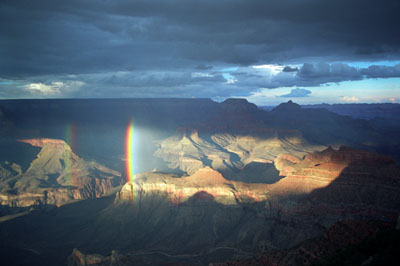
Double Rainbow in the Grand Canyon
September 1996 - Just as the Sun entered the narrow slot between the base of the clouds and the flat horizon far to the west, light drizzle fell into the canyon creating this double rainbow. As the Sun continued to set, the rainbow grew until it became a complete double rainbow exceeding 180o. This image was Weatherwise Magazine's 1997 Grand Prize winner and issue cover.
Print No. B96-16
More images of the Grand Canyon
Berry Creek Falls and Rainbow
Walking up West Berry Creek from its convergence with West Waddell Creek, the first, and most impressive of the string of falls along the Berry Creek Falls Trail, is Berry Creek Falls. Cascading down 70 feet through lush ferns, if you catch the timing right, you might see a rainbow segment as a sliver of light works its way through the redwood forest.
Print No. A03-2-9
More images of Big Basin State Park, California
Golden Gate and Double Rainbow
Looking through the span between the two towers, the basal segments of the primary (left) and secondary (right) rainbows are visible below the low cloud base. Downtown San Francisco lies right between both segments.
Print No. A98-11-7
More images of the Golden Gate Bridge
Blowing Snowbow
This photo was taken from the Mount Washington Wilderness in central Oregon. Looking to the west, wind from an approaching storm on the west side of the Cascade Range whips over the peaks between Mount Jefferson and The Three Sisters. The winds blow the snow off the peaks and passes and fine ice crystals are carried over the distant forests to the east where the morning sunlight is reflected off of them. The resulting effect is an apparent "rainbow" in a clear blue sky. This image captured 3rd place in Weatherwise Magazine's year 2000 Photo Contest.
Print No. A99NW-18-8
Double Rainbow near Rio Vista
Shortly before sunset, a double rainbow forms over farmland near Rio Vista, California. The low angle of the Sun, coupled with thick rain shafts between the Sun and the rainbow, result in an intense reddish hue. The storm that produced this rainbow also produced several inches of hail and a tornado watch - very rare for this part of the country.
Print No. A02-2-5
Double Rainbow over the Oakland Hills
This double rainbow occurred during a late El Niņo spring shower. Taken from the Rockridge area of Oakland, the rainbow appears over a portion of the area that was devastated by the October 1991 Oakland Hills fire.
Print No. A98-21-2
Double Rainbow - Livermore Farm
This was a late November storm, the beginning of the rainy season. With the early morning Sun behind, this is the view looking west at the approaching storm.
Print No. A98-52-2
California's Old Faithful Geyser and Double Rainbow
The double rainbow here is the result of the water spray from the geyser. Spouting 350oF (177oC) water about 60 feet (18 meters) into the air, this geyser erupts on average every 40 minutes. When this photo was taken in June 1999, the average time between eruptions was 13 minutes, thanks to the rapid influx of water supplied by well-above-average rainfall from the prior El Niņo winters.
Print No. A99NW-2-2
More images of other California localities







